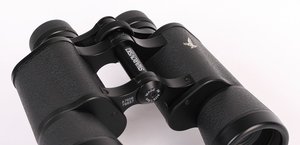Vixen New Foresta 10x50 DCF
As the name indicates the new series is supposed to supersede the old Foresta. It is a serious change – the old Foresta were classic Porro binoculars. It seems Vixed, launching a new series consisting of only roof prism instruments, is following a trend very popular lately. Fortunately the new models’ parameters remained intact – their fields of view are supposed to be similar to those of the earlier models.
All New Foresta binoculars are waterproof and nitrogen-filled; all air-to-glass surfaces are covered by high quality anti-reflection coatings. The roof prisms made of BaK-4 are faze-correction coated and additionally covered by reflection enhanced coating. Every New Foresta pair of binoculars comes with 5 years of warranty period.
| Magnification | Lens diameter | Angular field of view | Prisms | Eye relief | Weight | Price |
|---|---|---|---|---|---|---|
| 10 | 50 | 93/1000(5.3o) | BaK-4/roof | 18 mm | 760 g | 1099 PLN |
Summary
Pros:
- shapely and lightweight casing for the 10x50 class device,
- sensible transmission,
- slight astigmatism,
- properly corrected distortion,
- good quality prisms made of BaK-4,
- proper darkening and cleanliness inside the tubes,
- sharp image in the majority of the field of view,
- dark area near exit pupils,
- good quality coatings.
Cons:
- a bit too high chromatic aberration,
- slightly truncated exit pupils.
 |
We don’t doubt that the New Foresta series produced by the Japanese company Vixen is quite well done. In our tests we managed to take a closer look at the 8x32 and 8x42 models and both performed very well also featuring a very good price/quality ratio. As 10x50 parameters belong to the most popular ones we decided to check also the Vixen New Foresta 10x50.
The fact that the producer treats the parameters stated in the specifications and on the casing in a rather cavalier manner sticks out at once. Let’s remind that the New Foresta’s 8x32 field of view was noticeably higher in the specifications than in reality; here the situation is reversed. The producer declares a field of view of 5.3 degrees so not especially impressive for 10 times magnification. Fortunately the real field of view amounts to 5.83 degrees which is a very good value. For a change the diameter of objective lenses is a bit smaller than the declared 50 mm.
The weight and parameters of the tested lens deserve our praise. The following chart shows clearly that you deal here with one of the lightest binoculars in this class of equipment. Additionally in the photo below you see it is also quite handy.
 Delta Optical Forest II 10x50, Nikon Prostaff 5 10x50 and Vixen New Foresta 10x50. |
The 8x32 and 8x42 models had very good transmission levels for cheap roof prism instruments. Let’s check how the 10x50 model compares here.
 |
The situation is definitely better than in the case of the Delta Optical Forest II 10X50 and the Nikon Prostaff 5 10x50. In the red part of the spectrum the transmission reaches a very high level of 90% and in the centre of the visible spectrum it exceeds distinctly 80%. These are very sensible results at this price point. Of course we would like to see a flatter graph but, as we are already getting quite a lot there is no reason to complain.
It is very important that the binoculars not only had many good results in different categories (such as the astigmatism correction, distortion correction, flares or blackening) but also didn’t have any serious slip-ups. Of course we wish its chromatic aberration level was lower and the exit pupils less truncated but you have to remember you deal here with a shapely roof prism instrument costing only about 1000 PLN. There are no miracles and there had to be some compromises reached. Our final assessment of the tested binoculars is very positive indeed. It should be emphasized that the result of the new Vixen is comparable with the results of solid Porro instruments (like e.g. the Pentax PCF 10x50 WP, the Nikon Tundra 10X50 CF WP or the Leupold Mesa 10x50). If a roof prism device, costing the same amount of money as a Porro pair of binoculars, additionally achieves the same level of performance we don’t doubt it is a highly recommendable instrument.


















